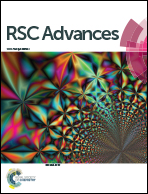A non-Bornian analysis of the Gibbs energy of hydration for organic ions†
Abstract
Recently, a non-Bornian model was successfully applied to evaluate the Gibbs energy of hydration (ΔG°hyd) for spherical ions (mainly inorganic ions). In this model, the long-range, Born-type electrostatic ion–solvent interaction is not explicitly included in the calculation of ΔG°hyd, since its contribution is small, whereas the short-range interaction, including Coulomb, polarization, and charge-transfer interactions, is considered as the dominant factor that determines the ΔG°hyd of ions. The ΔG°hyd scaled by the surface area of an ion can be given by a quadratic function of the surface field strength (E) of the ion. In this study, the non-Bornian model was further applied to organic ions with charged groups. Using the Gaussian 09 program package, the geometries of ions in vacuum were optimized at the B3LYP/6-311++G(2d,p) level, and the partial atomic charges were computed in the Mulliken, Merz-Kollman (MK), natural population analysis (NPA), Hirshfeld, and ChelpG methods. Introducing a new subprogram, we could estimate local electric fields on the ion surface (van der Waals surface or solvent-accessible surface (SAS)). This enabled us to perform regression analyses based on the non-Bornian model, by using the experimental values of ΔG°hyd for 109 ions. When the NPA-SAS combination was chosen, the best regression result was obtained, giving the mean absolute error of 4.3 kcal mol−1. The non-Bornian model would provide a simple and relatively accurate way of determining ΔG°hyd of ions.


 Please wait while we load your content...
Please wait while we load your content...